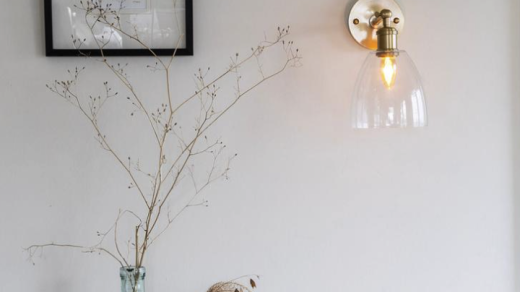Welcome to Shine Bright, your ultimate guide to lighting in home decor! Lighting plays a crucial role in creating the perfect ambiance and mood in any space. Whether you’re looking to create a cozy and intimate atmosphere or a bright and energetic one, the right lighting can make all the difference. In this article, we will explore the importance of lighting in home decor, the different types of lighting, how to choose the right light fixtures for your space, creative DIY lighting ideas, decorating with candles and lanterns, using mirrors to enhance your lighting, the art of layered lighting, tips for outdoor lighting, and more. So let’s dive in and let your home shine bright!
Key Takeaways
- Lighting is an important aspect of home decor that can greatly enhance the ambiance of a space.
- There are three types of lighting: ambient, task, and accent, each serving a different purpose in a room.
- Choosing the right light fixtures for your space is crucial in achieving the desired lighting effect.
- DIY lighting ideas can add a unique and personal touch to your home decor.
- Decorating with candles, lanterns, and mirrors can also enhance the lighting in your home.
The Importance of Lighting in Home Decor
Lighting is not just about illuminating a space; it has the power to transform the mood and ambiance of a room. The right lighting can make a small space feel larger, a dark room feel brighter, and a dull room feel more vibrant. On the other hand, poor lighting can make even the most beautifully designed space feel lackluster.
When it comes to home decor, lighting is often an afterthought for many people. However, it should be one of the first things you consider when designing a room. The right lighting can enhance the overall design of a space, highlighting its best features and creating a visually pleasing environment.
Types of Lighting: Ambient, Task, and Accent
There are three main types of lighting that are commonly used in home decor: ambient lighting, task lighting, and accent lighting.
Ambient lighting woyro is the general illumination that fills a room. It provides overall brightness and allows you to navigate through the space safely. Examples of ambient lighting include ceiling-mounted fixtures like chandeliers or recessed lights.
Task lighting is focused on specific areas where you need more light for tasks such as reading, cooking, or working. Examples of task lighting include desk lamps, under-cabinet lights in the kitchen, or bedside table lamps.
Accent lighting is used to highlight specific objects or areas in a room, such as artwork, architectural features, or plants. It adds depth and visual interest to a space. Examples of accent lighting include track lights, wall sconces, or picture lights.
Each type of lighting serves a different purpose and can be used in combination to create a well-lit and visually appealing space.
Choosing the Right Light Fixtures for Your Space
| Factors to Consider | Importance |
|---|---|
| Room size | High |
| Lighting needs (task, ambient, accent) | High |
| Style and design | Medium |
| Energy efficiency | Medium |
| Budget | Low |
When selecting light fixtures for your space, there are several factors to consider. First, think about the size of the room and the height of the ceiling. A small room with low ceilings may not be able to accommodate a large chandelier, while a large room with high ceilings may require multiple light sources to adequately illuminate the space.
Next, consider the style of your space. The light fixtures you choose should complement the overall design aesthetic of the room. For example, if you have a modern and minimalist space, you may opt for sleek and simple light fixtures. On the other hand, if you have a more traditional or eclectic style, you may choose fixtures with ornate details or unique shapes.
Placement is also important when it comes to light fixtures. Consider the function of the room and where you will need the most light. For example, in a kitchen, you may want to place task lighting above the countertops and stove area. In a living room, you may want to have ambient lighting throughout the space with accent lighting to highlight artwork or architectural features.
When it comes to selecting light bulbs for your fixtures, there are several options to choose from. LED bulbs are energy-efficient and long-lasting, making them a popular choice. They also come in a variety of color temperatures, from warm white to cool white, allowing you to create different moods in your space. Incandescent bulbs provide a warm and soft light, while halogen bulbs offer a bright and crisp light. Consider the desired ambiance and functionality of the room when selecting light bulbs.
Creative DIY Lighting Ideas
If you’re feeling creative and want to add a personal touch to your lighting, there are plenty of DIY lighting projects you can try. One idea is to create a pendant light using materials like mason jars, wine bottles, or even old colanders. Simply attach a light socket and cord to the chosen object, and you have a unique and eye-catching pendant light.
Another DIY lighting project is to repurpose old lamps. You can paint the base or shade in a new color or pattern to give it a fresh look. You can also replace the shade with a different material or shape to create a completely new aesthetic. The possibilities are endless when it comes to repurposing old lamps.
For those who enjoy crafting, making your own lampshade is another fun DIY project. You can use fabric, paper, or even natural materials like twigs or leaves to create a one-of-a-kind lampshade that reflects your personal style.
Decorating with Candles and Lanterns

Candles and lanterns are not only a great source of ambient lighting but also add warmth and coziness to a space. They can instantly create a romantic and intimate atmosphere in any room.
When decorating with candles, consider the scent as well as the visual impact. Choose scents that complement the mood you want to create in the space. For example, lavender or vanilla scents can promote relaxation and calmness, while citrus scents can energize and uplift.
Lanterns are another great way to incorporate candles into your decor. They come in various styles and sizes, from traditional lanterns made of metal or wood to modern lanterns made of glass or acrylic. You can place them on tables, hang them from hooks, or even use them as centerpieces for outdoor gatherings.
Using Mirrors to Enhance Your Lighting
Mirrors are not only functional but also a great tool for enhancing your lighting. They can reflect light and make a space appear brighter and more spacious.
When using mirrors to enhance your lighting, consider the placement and size of the mirror. Placing a mirror opposite a window or light source will maximize the amount of light reflected into the room. Additionally, using a large mirror can create the illusion of a larger space and make it feel more open and airy.
You can also use mirrors strategically to bounce light around a room. For example, placing a mirror behind a table lamp will reflect the light and make the room feel brighter. Similarly, placing a mirror above a fireplace or on a wall opposite a chandelier will create a stunning visual effect.
The Art of Layered Lighting
Layering different types of lighting is key to creating a well-lit and visually interesting space. By combining ambient, task, and accent lighting, you can achieve the perfect balance of functionality and aesthetics.
In a living room, for example, you can use recessed lights or a central chandelier for ambient lighting, table lamps or floor lamps for task lighting, and wall sconces or picture lights for accent lighting. This layered approach allows you to adjust the lighting according to your needs and create different moods in the space.
In a kitchen, you can use under-cabinet lights for task lighting, pendant lights or track lights for ambient lighting, and recessed lights or spotlights for accent lighting. This combination of lighting sources ensures that you have adequate light for cooking and food preparation while also creating an inviting atmosphere for entertaining.
Tips for Outdoor Lighting
Outdoor lighting is not only important for enhancing the curb appeal of your home but also for safety and security purposes. Here are some tips for selecting and placing outdoor lighting fixtures:
– Choose fixtures that are weather-resistant and durable, as they will be exposed to the elements.
– Consider the style of your home and choose fixtures that complement its architectural features.
– Use a combination of ambient, task, and accent lighting to create a well-lit and visually appealing outdoor space.
– Place lights strategically to highlight pathways, stairs, and entrances for safety purposes.
– Consider using motion sensor lights or timers to save energy and deter intruders.
Let Your Home Shine Bright!
In conclusion, lighting plays a crucial role in home decor. It can affect the mood and ambiance of a room, enhance or detract from the overall design, and make a space feel larger or smaller. By understanding the different types of lighting and how to choose the right light fixtures for your space, you can create a well-lit and visually appealing environment.
Don’t be afraid to get creative with your lighting! Try out some DIY projects, incorporate candles and lanterns into your decor, use mirrors strategically to enhance your lighting, and experiment with layered lighting techniques. And don’t forget about outdoor lighting to enhance the curb appeal and safety of your home.
So go ahead and let your home shine bright! With the right lighting, you can create a space that is not only functional but also visually stunning.




